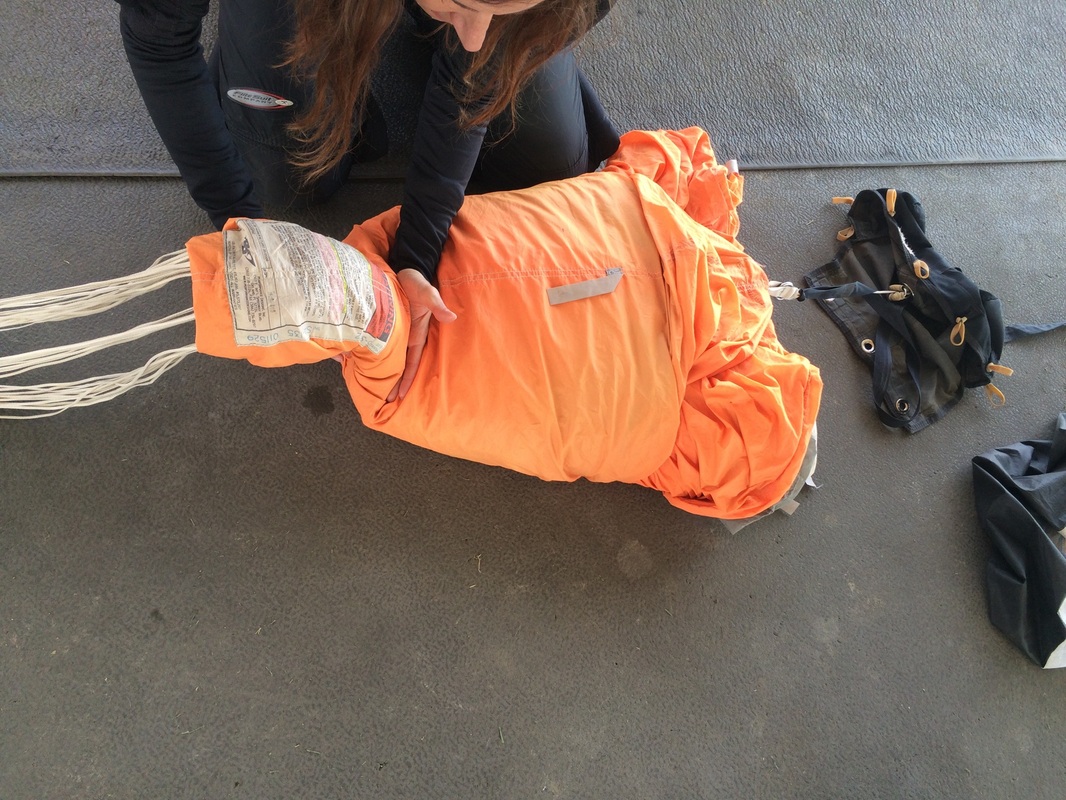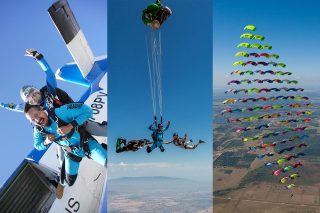How difficult is it to pack a parachute, and can you do it yourself?
Skydiving
Posted by: Skydive Perris
2 years ago

Ah, the parachute. The wondrous feat of engineering that allows us to glide safely back to earth after every successful skydive!
While packing a parachute can seem like a herculean endeavor, learning how to pack a parachute is not only a requirement to attain a United States Parachute Association (USPA) skydiving A-License, but it’s often seen as a rite of passage in the transformation from neoflyer to licensed skydiver.
Admittedly, at the start, navigating the numerous folds of nylon won’t be easy. But with proper instruction and plenty of practice, you can learn to pack a parachute.
What is packing a parachute?
The process of “packing a parachute” refers to folding the parachute material and the lines back into the parachute container. However, all parachutes are not the same. Every skydiving system used in civilian jump operations features a dual-parachute system. As the name implies, there are two parachutes packed within one skydiving container: a main parachute and a reserve parachute. There are substantial differences in the environment in which each is packed; the time it takes to pack; and the certification needed to pack each type of parachute.
Packing A Main Parachute
According to the Skydiver Information Manual, the main parachute may be packed by either an FAA rigger, a non-certificated person under the supervision of an FAA rigger (FAR 105.43.a), or the person who intends to use it on the next jump (FAR 105.43.a).
However, it should also be noted that this doesn’t mean just anyone should pick up a parachute and try to pack. Section 5-3 L of the Skydiver Information Manual also has two specifications with regard to packing knowledge:
- Each individual skydiver should have the written approval of an S&TA, USPA Instructor, I/E, or an FAA rigger to pack his or her own parachute.
- All parachute packers should know and understand the manufacturer’s instructions for packing, maintenance, and use.
How do you pack a parachute?
There are a few different ways to pack a main parachute. Here are two parachute packing methods.
1) Flat Packing
Flat packing is an older packing technique that is sometimes used by “old-school” skydivers and many BASE jumpers.
In this style of packing the parachute is stretched out and laid flat on the ground, and remains that way throughout the majority of the packing process. This packing style is significantly more time-intensive than the other method of parachute packing.
Example video of flat packing a parachute:
2) Proper Ram-Air Orientation (PRO) Packing
PRO packing is the most common method of parachute packing. This style of packing was specifically designed for the modern, square parachute. The goal of PRO packing is to fold the parachute into the container in the best orientation for it to quickly fill with air as it deploys.
In this packing style, the canopy is stretched out and laid on the ground to ensure line continuity. However, afterwards, it is then draped over the individual’s shoulder for a portion of the packing process. PRO packing a parachute is substantially quicker than flat packing and can be done in 10 to 15 minutes by most skydivers. This packing method is the one we teach to students in our Perris Student Program.
Example of PRO packing a parachute:
Packing A Reserve Parachute
Packing a reserve parachute is an extremely detailed and time-consuming process. While main parachutes can be packed on grass or carpeted surfaces, reserve parachutes are packed almost exclusively within designated rigging lofts, like the one we have on-site for your convenience. Because reserve parachutes are an important safety feature, the individuals who are responsible for packing reserve parachutes must have specific certifications. The Federal Aviation Administration (FAA) requires that the reserve parachute is inspected and repacked every 180 days by an FAA-certified parachute rigger.
Pick The Right Main Parachute Packer
As a licensed skydiver, once you have taken your packing class, you are free to use and pay a rigger (or a packer supervised by a rigger) to pack your main parachute after each of your jumps.
However, it is important to pick the right packer. When not packing for yourself, your packer acts as your “eyes.” You need someone who values safety first and foremost, and is thorough – paying great attention to details such as wear and tear, a frayed closing loop, or maybe even a small hole in your canopy. Part of the packing process is checking as you go that your rig is in good condition, and when someone else packs it, you may miss some important safety-related details.
Take Parachute Packing Seriously
For skydiving to be fun, the many precautions and processes in place must be respected. It is not recommended for you to teach yourself to pack or to attempt to learn from YouTube videos. If you’re interested in learning to pack a parachute, please see one of the staff here at Skydive Perris. We would be happy to set you up with a parachute packing class.





